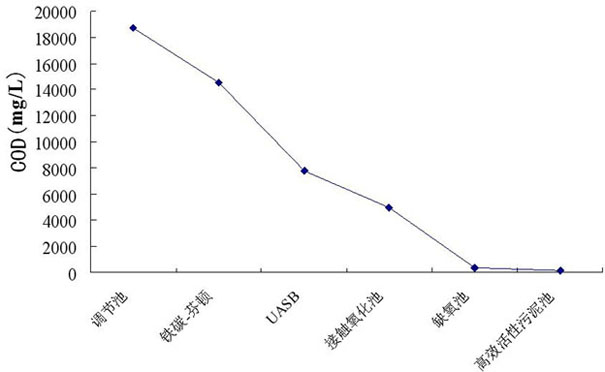Caffeine production wastewater treatment method
A technology for producing wastewater and treatment methods, applied in biological water/sewage treatment, natural water treatment, sustainable biological treatment, etc. Decolorization function, high adsorption coagulation activity, the effect of overcoming polarization
- Summary
- Abstract
- Description
- Claims
- Application Information
AI Technical Summary
Problems solved by technology
Method used
Image
Examples
specific Embodiment approach 1
[0017] Specific embodiment one: the treatment method of caffeine production wastewater in this embodiment is as follows: one, the caffeine production wastewater is passed into the regulating tank, the pH of the wastewater is adjusted to 4 ~ 8, and the hydraulic retention time is 1 ~ 4h; The effluent of the pool is connected to the iron-carbon-Fenton oxidation pool, and then the volume concentration is 0.10L / m 3 ~0.50L / m 3 Add hydrogen peroxide into the iron-carbon-Fenton oxidation tank, and adjust the pH value to 4~5, and the hydraulic retention time to 2.0h~5h, in which Fe 2+ The concentration is 50~200mg / L; 3. Connect the effluent from the iron-carbon-Fenton oxidation tank to the air flotation tank, and the hydraulic retention time is 1 to 4 hours; 4. Connect the effluent from the air flotation tank to the upflow anaerobic sludge bed (UASB), the concentration of anaerobic sludge in the reactor is 15kg / m 3 ~30kg / m 3 , oxidation-reduction potential ORP3 ~20kg / m 3, the diss...
specific Embodiment approach 2
[0021] Embodiment 2: This embodiment differs from Embodiment 1 in that in step 1, concentrated sulfuric acid with a mass concentration of 98% is used to adjust the pH of the wastewater to 4-8. Other steps and parameters are the same as those in Embodiment 1.
specific Embodiment approach 3
[0022] Specific embodiment three: the difference between this embodiment and specific embodiment one or two is that in step two, concentrated sulfuric acid with a mass concentration of 98% is used to adjust the pH value to 4-5. Other steps and parameters are the same as those in Embodiment 1 or Embodiment 2.
PUM
| Property | Measurement | Unit |
|---|---|---|
| Cod | aaaaa | aaaaa |
| Cod | aaaaa | aaaaa |
Abstract
Description
Claims
Application Information
 Login to View More
Login to View More - R&D
- Intellectual Property
- Life Sciences
- Materials
- Tech Scout
- Unparalleled Data Quality
- Higher Quality Content
- 60% Fewer Hallucinations
Browse by: Latest US Patents, China's latest patents, Technical Efficacy Thesaurus, Application Domain, Technology Topic, Popular Technical Reports.
© 2025 PatSnap. All rights reserved.Legal|Privacy policy|Modern Slavery Act Transparency Statement|Sitemap|About US| Contact US: help@patsnap.com

